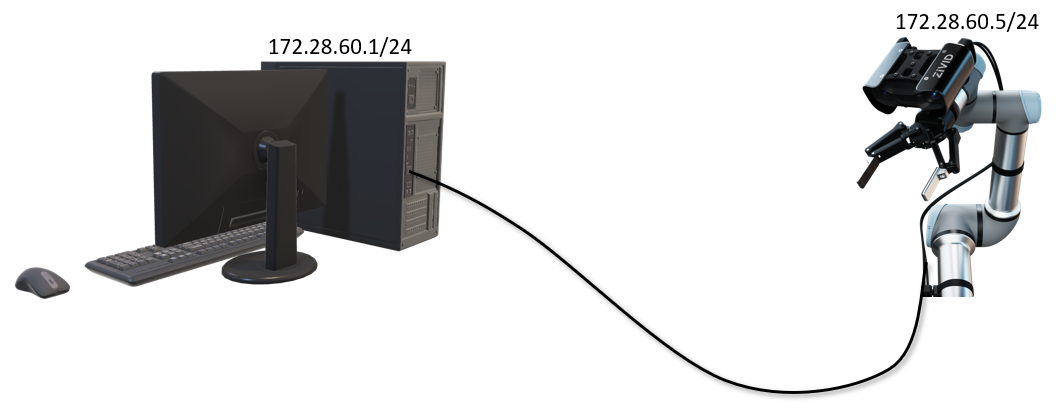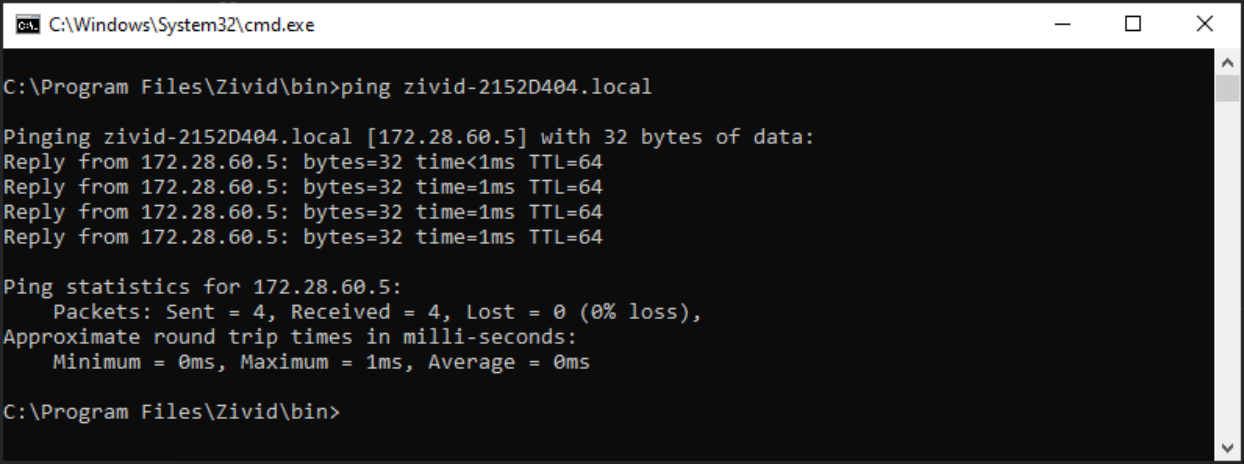Zivid Two Network Configuration
Caution
The correct instructions for network configuration will depend on your SDK version. Choose your SDK version in the top left drop-down.
The Zivid Two camera uses Ethernet communication and needs 10 Gbps for best performance. Your computer may not have a port for 10 Gigabit Ethernet. In that case, you can connect to it using a Thunderbolt 3 to 10GbE Adapter. At a reduced performance you can also use USB to 5GbE, 2.5GbE, or 1GbE adapters.

Requirements
Performance |
Network |
Interface |
Connection |
|---|---|---|---|
Optimal (recommended) |
10GbE (10Gbps) |
PCIe card |
Direct |
Very good |
10GbE |
Thunderbolt Adapter |
Direct |
Reduced |
5GbE or 2.5GbE |
PCIe/USB/Thunderbolt Adapter |
Direct/Switch |
Minimum |
1GbE (1Gbps) |
PCIe/USB Adapter |
Direct/Switch |
Caution
USB-based network adapters have reduced and more variable capture speed, and can occasionally give errors when using the camera.
Default configuration
IP |
Subnet mask |
Gateway |
Hostname |
|
|---|---|---|---|---|
Zivid Two |
|
|
|
|
Possible PC |
|
|
|
Each camera is shipped with the default static IP as listed in the table above. Suppose you have not configured the camera in any way before this tutorial, or you know that the camera is still in its default configuration. In that case, you may connect to it after configuring the interfacing network card of your PC. Go to Static IP Network Configuration - PC in order to do this.
Custom configuration
A custom configuration is necessary if, for example:
You want to change the IP or hostname of the camera
The camera is not in its default configuration
You want to connect to multiple cameras
The default IP is in conflict with the IP range in the internal network
You want to restrict which cameras Zivid SDK can connect to
This can involve changing the static IP of the camera and PC, but also configuring them to dynamic modes. The custom configuration is divided into static IP and dynamic IP configuration.
Static
This is the default configuration for the camera, which comes with static IP 172.28.60.5.
If you want to change the IP of the camera or know the IP has changed, you may have to configure the IP of the interfacing network card.
The following guides describe how to change and configure static IP for both the PC and camera:
Dynamic
The camera also supports automatic IP configuration using either DHCP or link-local. When configured to use an automatic IP, the camera will first try to obtain an IP address using DHCP (within ~45 seconds). Getting an IP address from a DHCP server requires a DHCP server running either on a router on the network or locally on the PC. If no DHCP server is available, the camera will fall back to a link-local IP address (after ~45 seconds).
The following guides describe how to configure dynamic IP for both the PC and camera, either using DHCP or link-local:
Cameras.yml and how to restrict discoverable cameras
In SDK 2.7 and earlier, a file Cameras.yml was required to connect to cameras with non-default IP.
This is not required from SDK 2.8 and onwards, but it may still be used to restrict which IP addresses and hostnames Zivid SDK can connect to.
Use the drop-down below for more information about how Zivid SDK discovers cameras and how Cameras.yml can be used.
Cameras.yml and how Zivid SDK discovers cameras
How does Zivid SDK find cameras?
From SDK 2.8, Multicast DNS (mDNS) is supported for auto-discovering cameras with non-default IPs that are in the subnet range of the interfacing network card.
In SDK 2.7 and earlier, cameras with non-default IPs had to be listed in the Cameras.yml file in the Zivid configuration folder, which the SDK searched through to discover cameras.
Even though mDNS removes the requirement of Cameras.yml, this file may still be used to override which cameras the SDK can search for.
From SDK 2.8, Cameras.yml therefore has the function of restricting which cameras the PC can connect to, if provided.
If Cameras.yml exists, mDNS will not be used.
Users upgrading to SDK 2.8 or later versions with an existing Cameras.yml will have the same network discovery as before.
If you wish to use mDNS you can delete the existing Cameras.yml.
See the pseudo code below for a top-level view of how the SDK looks for a camera on the network.
def find_camera():
if exists(Cameras.yml):
for IP in Cameras.yml:
connect(IP)
for hostname in Cameras.yml:
connect(hostname)
else:
connect_mDNS()
Cameras.yml
If you wish to restrict the IPs Zivid SDK searches for, download Cameras.yml and place it in the Zivid configuration folder, as shown below.
mkdir %LOCALAPPDATA%\Zivid\API
move %HOMEPATH%\Downloads\Cameras.yml %LOCALAPPDATA%\Zivid\API\
mkdir --parents "${XDG_CONFIG_HOME-$HOME/.config}"/Zivid/API
mv ~/Downloads/Cameras.yml "${XDG_CONFIG_HOME-$HOME/.config}"/Zivid/API/
Caution
Zivid configuration files must use .yml file extension ( not .yaml).
Some examples of how Cameras.yml can look like are shown below, either using hostnames or IP addresses.
__version__: 1
Cameras:
NetworkCameras:
- NetworkCamera:
Host: zivid-2152D404.local
- NetworkCamera:
Host: zivid-20205M19.local
- NetworkCamera:
Host: zivid-21389K63.local
__version__: 1
Cameras:
NetworkCameras:
- NetworkCamera:
Host: 172.28.60.5
- NetworkCamera:
Host: 172.28.60.6
- NetworkCamera:
Host: 172.28.60.7
Discovering and connecting to the camera
Note
For some of the above configurations you will need to configure both the camera and PC. If you have followed a configuration that requires this, make sure you have configured both before going forward.
Assuming you have followed either Default configuration or Custom configuration, you should now be able to discover and connect to the camera. Be aware that the first time a camera is connected to in a process, it can take 10-20 seconds before it connects. There are multiple ways to discover the camera:
Open Zivid Studio and check that it can discover and connect to the camera.
Use the
ZividListCamerastool:Tip
ZividListCamerasis installed alongside the Zivid SDK on Windows, and with the zivid-tools package on Ubuntu. If you are unsure whether this tool has been installed, follow the Software Installation guide.

Ping the camera via IP address or hostname
zivid-<hostname>.local(e.g.zivid-2152D404.localin default configuration where the hostname is the serial number):

Hint
The status LEDs at the back of the camera show the current link capacity.
If you are not able to discover and connect to the camera with any of the above-mentioned methods, you may need to do a network reset on the camera.
Follow the troubleshooting article Zivid Two Unknown IP Configuration for instructions on how to do this.
This will configure the camera back to its default network configuration with static IP 172.28.60.5.
Version History
SDK |
Changes |
|---|---|
2.8.0 |
Added support for auto-discovery using Multicast DNS, removing the requirement of |
2.7.0 |
Added support for name queries ending with the |